The First Year of Life
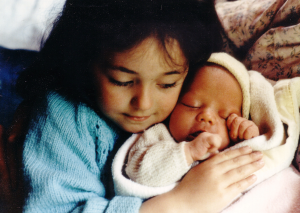
View/download as pdf First Year
Background
The Gesell Institute of Child Development has observed that children go through a repeating sequence of six different stages with predictable changes in mood and behaviour in each. Behaviour in these stages seems to alternate between being in equilibrium and in dis-equilibrium. Some stages are more expansive, some more inward, some more amenable, some outright challenging! The First Year includes nine of these stages, with the length of each stage increasing slightly as the year progresses from possibly one month to two months. The stages then repeat themselves throughout childhood, increasing in length incrementally through the first seven years when the stages became consistently one year in length.
The behaviour observed in these stages reflects the qualities associated in tradition with the planets—in the First year starting at birth with Saturn, then a full cycle (of Moon, Mercury, Venus, Mars, Jupiter and Saturn again,) and then Moon and Mercury repeated again.
While each individual child has their own temperamental tendency (however these may be defined), it is also clear that every child is also given, repeatedly through these childhood stages, an opportunity to experience many different ways of being. See Brief descriptions of planetary qualities for a quick reference guide for the qualities of each mature planetary type.
It is hoped that these brief descriptions of the stages with their planetary qualities in the First Year will be useful for a better understanding of the changing moods and motivations of the baby as they grow, especially when read in conjunction with other books about this first year. They show that growth is not just an ‘incremental increase’ on what was there before, but an unfolding of varied and special opportunities that rhythmically present themselves for development. Awareness of these may help us to celebrate and delight in the changes we see in the child’s development—sometimes more in the direction of socialisation, communication and language, sometimes more towards the achievement of tasks (like exploring their near environment), sometimes towards truly human achievement and independence in standing upright (what joy is felt!) and, finally towards the end of this year for many, walking. More observation is needed on the stages in this first year, as the information is sometimes scant compared to later ages.
We will include the naming of the stages in weeks because it can be confusing when Gesell research uses for example ‘Nine months’ (meaning roughly 40 weeks) and others, like Caplan quoted below, use the ‘ninth month’ meaning Eight months (roughly 36 weeks). The timing for Gesell is still approximate but can help us to observe more precisely when the motivations and the qualities of one stage are changing to those of the next stage. This can help us to adjust our responses to, and expectations of, the children accordingly.
Quotes in single quote marks or indented come from Gesell unless otherwise specified.
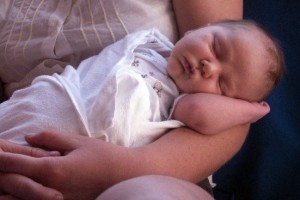
Birth to 4 weeks
A stage with Saturn qualities
Although the Gesell research is not absolutely definitive about the stage of birth, their early observations put birth at their Stage 6 which they observed at other ages to be a stage in ‘disequilibrium, neurotic , inwardized and troubled’ and with what we find are Saturn qualities.
Stage 6 in Gesell’s observations often seems to involve the completion of the growing cycle, where a fuller maturation is completed by the end of this stage. This would imply then that birth, despite its profound significance in life, is not the beginning of the growth cycle but rather the completion of one. So Gesell comments in 1940 about the newborn child:
In a sense, he is not fully born until he is about 4 weeks of age. It takes him that long to attain a working physiological adjustment to his postnatal environment…Frequently the neonate seems to be in a twilight zone between sleeping and waking. He is quasi-dormant. …At 4-16 weeks still neonate, he then starts moving more deeply into environment.
Yet in nature Saturn is associated with the seed, which lies at the culmination of the plant growth process and at the beginning of a new growth cycle. It is the transition point between end of one cycle and the beginning of another. Birth for the human is the transition from womb life (where the child is dependent on the mother for physical nourishment through the flow of blood through the placenta) into the world. At birth, the heart must close this route of maternal nourishment and become self-contained for blood circulation; the lungs must do their own breathing; and nourishment must come through the child’s own digestive processes, in a gut already prepared with gut flora to support this work. The child is also provided with strong survival reflexes to see them through this time when they must learn to adjust as an independent entity in an outside environment.
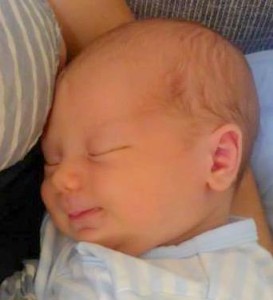
Self-containment and relative inwardness is characteristic in the newborn, as it is in the Saturn type of person. The beautiful fleeting Buddha-like smile of the newly born baby is a response to an inward stimulus. A smile in response to the outer environment, a social response, generally comes after this stage at 4- 6 weeks.
Traditionally, Saturn is also the great force behind the incarnation of the human spirit; it is the influence in astrology which keeps us on our true life path. Here it could be the influence that supports the child through birth, that very significant point for incarnation: that first meeting with the outer world. The Saturn stage is also one that occurs at other significant points of human growth, like standing upright, nine years and 21 years.
There is a phenomenon reported by some people about new born babies, which fits with this picture of the powerful incarnating force of Saturn at work in birth. Some people describe how immediately or soon after birth, the baby has looked at them with such deep intensity that they felt they were being examined by a wise old soul. One mother described feeling at that moment she recognised the individuality who would later become her son, an impression which soon faded as he became ‘a baby’ again. The accuracy of this impression regarding her son’s individuality was only to be confirmed when he grew up. People seem to experience the power of the baby’s individuality in these encounters. Could this be the individuality of the baby incarnating very deeply in that moment, like an “Oh, I am here!” and “Oh, it is you!” and then he or she withdraws a little again, to come in again slowly through childhood?
It is interesting that in Balinese tradition, the child is not really considered to be of the earth until this stage is over at 42 days, when it is considered their personality starts to unfold and they are given their name.
So it seems that the time of birth and the weeks following it is truly a time of transition from womb to world and occurs with the support of the influences and qualities of Saturn, not Moon. Moon is the planet associated with new growth (the root in plants) and youthful forces in the human being. It is the next to bring its influence to the growth of the child.
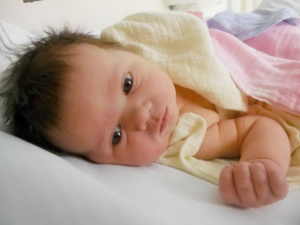
4 to 8 weeks: One month
A stage with Moon qualities
The next stage, which has the character which Gesell named Stage 1, while still tentative in timing, is put at 4 to 6-8 weeks. They characterise Stage 1 in the older age groups as ‘in equilibrium and smooth’, a Moon stage.
Gesell has given us relatively little information on this age in infancy, but it is interesting to note that 4 weeks is the time when babies start to wake up to the world. Their eyes are wide open! They respond to the world, to their mothers’ faces, and briefly attend to moving objects. The first regular smiles in response to a face come. Gesell notes ‘He responds positively to comforts and satisfactions, and reacts negatively to pain and denial’. The physiological functions in the baby, in heart, breathing, temperature control have become more regular. By 6 weeks their eyes are beginning to coordinate efficiently and follow an object for a short distance; the outside fingers on the hand are stronger.
Further, Gesell comments:
The month old baby is no longer a neophyte in the elementary art of living. He breathes with regularity, his heart has steadied its pace, his body temperature has ceased to be erratic. His muscle tone is less fluctuant than it was in the days of long ago when he was a new born. He has reserves of muscle tone… His or her reactions have become more configured….we see the germs of language, of sociality, perception, intelligence, body posture, and even locomotion. The neuromotor system is organizing apace. The mind is growing.
In these few weeks, at 4 to 6-8 weeks, children meet the world in a new way. Developmentally children are at a new beginning, consistent with Moon influences supporting the first stage of growth.
This is very little to go on but observation may confirm whether this month shows other qualities associated with the Moon; good health and wellbeing, sociability, a priority given to relationship, and an amenable and easy going nature. This may show up more in the contrast to the stages either side.
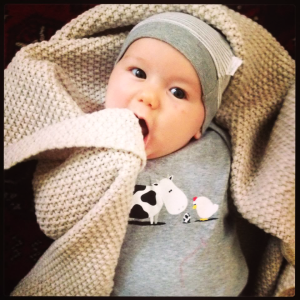
8 to 12 weeks: Two months
A stage with Mercury qualities
The next stage, which had the character which Gesell named Stage 2, is tentatively timed at 6-8 to 12 weeks and may go beyond this to about 14 weeks. They characterize Stage 2 in the older age groups as ‘in disequilibrium and breaking up’, a stage with Mercury qualities.
By 8 weeks their legs are active and they can roll and swing their hips and muscles are coming into more voluntary control rather than being reflexive. They are observant and responsive; they smile immediately and spontaneously; expressiveness and vocalisations increase. In the next weeks, the child grows in movement, coordination and communication, fitting for a Mercury stage. Observation may confirm whether the kind of unsettled movement seen in later Stage 2 ages can also be seen at this young age.
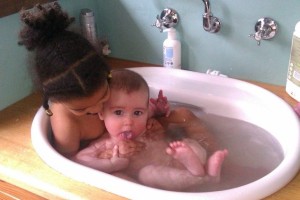
16 to 20 weeks: (Late Three &) Four months
A stage with Venus qualities
The next stage, which had the character which Gesell named Stage 3, is tentatively timed at 16 to 20 weeks. They characterise Stage 3 in the older age groups as ‘in equilibrium, rounded and well balanced’, a stage we have found has Venus qualities. We assume that 16 to 20 weeks must be the time that most clearly shows the characteristics of Stage 3, though the period may start before this if the stages are increasing incrementally, perhaps at about 14 weeks.
Gesell describes 16 weeks briefly as an age where the child likes to be held for brief periods in a seated position ‘so that he may face the world eyes front’. He still has limited control of his hands at this stage but social contact is expanding, consistent with Venus qualities.
There is something prophetic in the way in which the sixteen-week-old infant relishes the sitting position. His eyes glisten; his pulse strengthens, his breathing quickens, and he smiles as he is translated from horizontal to perpendicular. This is more than athletic triumph. It is a widening of the visual horizon; it is a social orientation.
Social behaviour both personal and interpersonal has greatly expanded. He or she coos with contentment, chuckles, laughs aloud. The child used to smile only on gastric occasions, but now imitates a social smile, and also smiles responsively and vocalizes on social approach….The sixteen week old child is usually well adjusted both to the world of things and to the world of persons. This is partly because he derives such great satisfaction from the free use of his eyes. He frets when his visual hunger goes unappeased. He quiets when ocular and social stimuli combine to feed his appetite for visual experience.
This really is scant information but it is interesting that this new development is both social and visual, both qualities associated with Venus.
These first four months have given the child a social orientation consistent with Moon, Mercury and Venus. A strengthening of the coordination of the body has occurred, preparing for a significant increase in activity which takes the child further out into the world in the following months, perhaps supported by the influences of Mars, Jupiter and Saturn. For the next few months are more action-driven than social, though speech (also associated with Mars) starts to flower.
20 to 24 weeks: Five months (& Early Six months)
A stage with Mars qualities
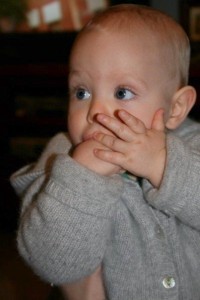 The next stage, which had the character which Gesell named Stage 4, is tentatively timed at 20 to 24 weeks, but if the stages are increasing incrementally, this stage would possibly be longer, perhaps taking it to 26 weeks, where the later revised Gesell schedule starts the next stage. Gesell characterise Stage 4 in the older age groups as ‘in disequilibrium and inwardised’, a time we observe has Mars qualities.
The next stage, which had the character which Gesell named Stage 4, is tentatively timed at 20 to 24 weeks, but if the stages are increasing incrementally, this stage would possibly be longer, perhaps taking it to 26 weeks, where the later revised Gesell schedule starts the next stage. Gesell characterise Stage 4 in the older age groups as ‘in disequilibrium and inwardised’, a time we observe has Mars qualities.
Gesell has given us relatively little information on 20 weeks. We can find a few clues elsewhere however. The Princeton Center for Infancy and Early Childhood in the book The First Twelve Months of Life, edited by Frank Caplan, offers a few insights in their chapter on the infant at Five Months which includes much of the 20 to 24 week period of Gesell. They begin in the chapter on the Fifth Month which is called, interestingly, ‘Reaching Out’:
Brace yourself, the fifth month is the first phase of a fantastic speed up of activity that will leave you breathless by the end of his first year. The quiet of the first four months is over.
How appropriate given that Mars may be driving growth at this point!
The child’s vision and ability to reach and grasp has matured to the point when the baby is no longer content to just watch. Caplan continues ‘Shortly before five months [20 weeks?] the baby can bring his hand rapidly from outside his field of vision to an object he is looking at and grasp it smoothly.’ ‘This exciting growth in eye, hand and body control, as Dr Piaget says, is the first major thrust of infancy.’ Thrust. There is a Mars word again. The baby now will want to ‘feel, hold, turn, shake and taste’ and may ‘howl with frustration’ when he cannot reach an object to examine it fully. With reach and grab capability he has more sense of the world apart from himself, of ‘before’ and ‘after’. With all this the baby becomes an early riser, keen to practice his new skills and eventually demanding adult help to explore further. He ‘actively responds to its excitements and frustrations.’
‘For most babies, these antic urges spurt and ebb. But a quiet baby handles his developmental awareness more subtly. …Many more active infants are only happy when they are in continuous motion—performing on their own or handled vigorously.’ ‘At night, a really active baby may wake several times because of the added excitement of this developmental surge. During the semiconscious phase of his sleep cycle he can wake up fully and try to comfort himself with activity because it is a characteristic activity for him.’ Activity at night is not a solution but they do suggest that a ‘late night play period will release some of his energy more profitably’, as might some ‘daytime exercise sessions.’
This is interesting that they suggest extra physical activity for this Mars stage. This may be a useful remedy for an over-active Mars in childhood—opportunities for more vigorous physical movement. (All the more reason that small children and infants particularly should not be kept ‘entertained’ with screen activities for these ‘freeze’ movement.)
The children of this age show new independence or a preference for the ‘task’ at hand. Caplan continues ‘About the fifth or sixth month, many mothers say they feel left out. As their babies become more competent physically, they see the end of their child’s need for mother despite the reality that his need will continue for many years.’ Interest in breast feeding lags (first of three lags) because the visual distractions are now available.’ Is it possible that this is a ‘task and outer world orientation’ driven by Mars? We see it again at the next Mars age at Fifteen months. It also continues into the Jupiter stage of Eighteen months and to some extent in the Saturn stage at Twenty one months. At these ages too the children can treat people like objects. This compares with the people orientation of the Moon, Mercury and Venus stages.
Caplan again ‘This is the month your baby obviously starts serious “language study.”’ Following months of preparation, the ‘baby will deliberately use his newly found vocal skill to intrude upon your attention to other things so you will focus them where he thinks they should be— on him.’
So here, even in the infant we find some possible signs of Mars behaviour: increased activity, increased speech, increased independence, possible ‘task orientation’, and using activity as a comforter.
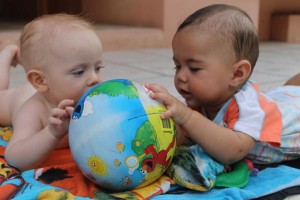
26 to 32 weeks: Late Six, Seven & Early Eight months
A stage with Jupiter qualities
The next stage, which had the character which Gesell named Stage 5, is tentatively timed at 26 to 32 weeks. They characterise Stage 5 in the older age groups as ‘in equilibrium , vigorous and expansive’, the stage we find has Jupiter qualities.
Again, Gesell has given us relatively little information on this specific age. Caplan describes this age (26 -30 weeks) as ‘one big gush of motor development.’ He describes how the children practice their new motor skills for hours on end; this typically involves creeping, but children differ greatly in this, and some may be crawling already or even standing. Even the quieter children may be intently practising hand manipulation. They sit firmly at this stage. Physically and visually they are actively moving into the world, exploring both themselves and their environment.
The previous Mars stage got the children moving, now one can imagine the influences of Jupiter working in the children as they get control of and strengthen their muscles and their coordination in readiness to stand in the next stage. The coordination of the higher and lower brain involved in the complex movement of crawling is now in preparation, being practised step by step. In later Stage 5 ages, one sees Jupiter working in awareness of, and enjoyment of, muscles and in ‘athletic’ activities; here one sees it in the development of the strength to crawl and stand. This also applies to the use of their hands and in increasing finer motor control, preparing the pincer grip.
Gesell describes 28 weeks in the following way:
Touch hunger follows visual hunger. Or rather, the two now combine; for the twenty eight week old baby is bent on manipulating everything he can lay his eyes and hands on….Note with what concentrated attention the baby exercises his growing powers…So engrossing is his self activity that he can amuse himself for long periods. But he can smile at onlookers and is usually friendly with both familiars and strangers. Indeed he represents an amiable union of self-containedness and sociality. He listens to words spoken by others; he listens also to his own private vocalizations.
At this stage the child’s abilities are in good balance. His behaviour patterns and trends are in focus. He is so harmoniously constituted that he causes few perplexities on the part of his caretakers. It is a period of short lived developmental “equilibrium.”
Self-containedness and sociality are also descriptions of Jupiter. So we find a number of Jupiter qualities, including more muscular activity and expansiveness.
32 to 40 weeks: Eight months, Younger Nine months
A stage with Saturn qualities
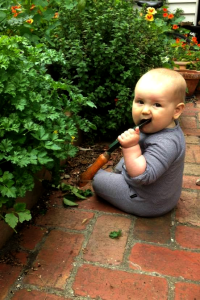 The next stage brings us back to where we started at birth, with Stage 6 and Saturn qualities, the stage they characterised as being ‘in disequilibrium, neurotic, inwardized and troubled’. It begins at Eight months– at about 32 weeks and it may be that the final week at the end of this stage (40 weeks?) actually belongs in the next stage, Stage 1 and Moon.
The next stage brings us back to where we started at birth, with Stage 6 and Saturn qualities, the stage they characterised as being ‘in disequilibrium, neurotic, inwardized and troubled’. It begins at Eight months– at about 32 weeks and it may be that the final week at the end of this stage (40 weeks?) actually belongs in the next stage, Stage 1 and Moon.
This stage takes us into a time of interesting growth. Again there is limited writing on this stage in Gesell so we have also turned again to Caplan. This is the time when most babies are developing their upright capacities—32 weeks appears to be the moment when many babies can get themselves to sitting upright and balance just for a moment independently without support. By 36 weeks they can sit alone for longer. 32 weeks is also the time when many can pull themselves to upright standing hanging onto something else, though they may not yet get themselves down again so easily. By the end of this period at 40 weeks many are ready to ‘cruise’, taking steps along a big object, hanging on, and ready to move forward into creeping, which leads into full crawling.
It is a very special moment, when human beings can achieve uprightness on their own. When the human brain is fully supported in the cerebral spinal fluid, which occurs in the upright position, and there is also the force of uprightness in the spine, it seems to bring the human being to a new inner strength and consciousness. This fact is in our language (‘he pulled himself to his full height’, ‘stand tall’, ‘upright’ as meaning a ‘strong moral character’). We also know this from our own experience, for example, that it is hard to confront someone strongly while lying prone— we pull ourselves up on our elbows at least, or straighten ourselves up, if we cannot stand! The impulse to be upright is a very powerful one in children, as parents who have to get up repeatedly in the night to lie the children down into their cots again will tell you. There is a look of such pleasure on their faces at their achievement, one can really only cheer them on and help them to develop the skill to sit down again by themselves! Is this Saturn, that planetary influence that supports the coming into life of the individual, which is driving this strong impulse at this stage? Sitting and standing upright alone also involve balance and the inner ear, an organ governed by Saturn. In kinesiology there is a relationship between the muscle latissimus dorsi in the back, which helps keep the back straight, and the spleen meridian associated with Saturn.
It is interesting that at this same time, the children also consolidate the use of the pincer grasp, where thumb opposes the fingers, another important characteristic which is associated with what makes us human. Further, it is also a time of increased consciousness when the children start to fear strangers and show more anxiety about separation from the major carer. In this are the beginnings of a new sense of separation of ‘self’ from ‘other’. In reference to the Eighth month (31 to 35 weeks approximately), Caplan says ‘he is also developing a memory of timing…This may be a first example of your baby’s ability to recall a past event rather than a past action of his own’.
This is very interesting that independent uprightness, balance, pincer grasp, increased consciousness, separation anxiety and new capacity to recall a past event, all come with Saturn influences which support individuation and consciousness.
40 to 44 weeks: (Older Nine months &) Ten months
A stage with Moon qualities
The next stage, which had the character which Gesell named Stage 1 again, while still tentative in timing, is put at 40 to 44 weeks, though it may start a little earlier than this if we are looking for clues in Moon qualities. Once again we see a Stage 1 characterised in the older age groups as ‘in equilibrium, smooth and consolidated’. The stage has an association with the Moon qualities of sociability, amenability, cooperativeness and consolidation of skills.
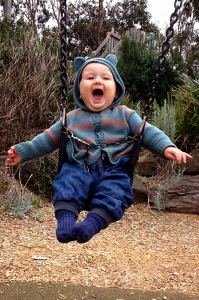 In the passages again quoted below from The First Twelve Months of Life, edited by Frank Caplan, they describe how there is a slackening off in action and activity which lasts from roughly 36 weeks through to 44 weeks consistent to some extent with the Saturn and Moon qualities that correlate to this time period.
In the passages again quoted below from The First Twelve Months of Life, edited by Frank Caplan, they describe how there is a slackening off in action and activity which lasts from roughly 36 weeks through to 44 weeks consistent to some extent with the Saturn and Moon qualities that correlate to this time period.
Caplan describes the time from roughly 36 to 40 weeks, which possibly could be part of this stage as well as part Stage 6 (Saturn) which comes before it:
After the tremendous surge of activity in the seventh and eighth months [roughly 26 weeks to 36 weeks], when your baby perfected his sitting and crawling abilities and began to stand, the ninth month [36 to 40 weeks] is a temporary slack. The baby uses this period before he walks to secure his impressive gains, to practice mental skills and acquire some social arts…The baby’s memory and other mental capabilities also improve.
One would not want to make too much of this, but both Saturn and Moon influences are normally consolidating stages, Saturn through its concentrating force and Moon influences through the archetypal Moon activity reproduction (practising) of what has gone before, both physically and mentally; both also involve mental abilities and memory in different ways. 40 to 44 weeks definitely reflect a new emphasis with a definite move in the direction of social, emotionally expressive Moon.
Caplan then describes 40 to 44 weeks, the timing of the original Gesell Stage 1:
Unless he is very active, his slow down in motor learning will very likely continue this month, but the lull is deceptive, for he is really gathering strength to carry him through that big step of walking. This month however, he will expend some of his energy on improving old skills, but he will devote more and more of it to social and personal growth.
Here again he is still practising what he has already learned and is growing socially.
The Gesell researchers do not say very much about this stage which they suggest includes 40 to 44 weeks but they do observe a little about more social behaviour in the children:
[At 40 weeks the child again] is penetrating more deeply into the social environment. He discriminates more sharply between familiars and strangers. He imitates gestures, facial expressions and sounds. He heeds “No! No!” He echoes “Da Da.” He probably has learned a nursery trick, which could not have done earlier.
Caplan adds more to this :
Your baby will show many real moods and emotions now, and grow more and more self-conscious and aware of social approval and disapproval…Most likely your baby cries now because of his fear of strange people, places and activities, or his unhappiness at being separated from you and other loved ones. Even emotional separations, such as the aftermath of a scolding, can make him look sad and hurt. He can sit daydreaming as if he has much to contemplate. He can also grow angry because you frustrate an activity he feels was important…Your baby probably extends his tenderness now to stuffed animals and other toys…Babies may also start to evolve a sexual identity…Memory of what is out of sight grows…
Stage 6, the Saturn stage, 32 to perhaps 38 weeks, has brought more self-consciousness. Now in this new stage, growth very consistent with Moon is appearing: deeper emotional life, day dreaming is possible, and consciousness of social approval, which reflects awareness of the behaviour of others, becomes evident, caring for other things grows with the imagination and a significant new step in the development of memory, also consistent with Moon qualities, makes possible an understanding about the permanence of objects. Could this new development be driven by the influences of Moon qualities? As Gesell says, development leads behaviour. We might add the question: do the planetary qualities and influences lead development?
However, it seems less likely that Eleven months (44 to 48 weeks) fits with Moon. It fits rather better with Mercury, which is where it was placed in the initial Gesell scheme; this might start Stage 2, the Mercury stage, nearer to 44 weeks.
44 weeks to 52 weeks: Eleven & Twelve months
A stage with Mercury qualities
This next stage, which Gesell named Stage 2 has the character of being ‘in disequilibrium and breaking up’. As already indicated, the original Gesell timing of this stage was at 44 to 52 weeks. This makes sense in relation to seeing planetary influences because we see more potentially Mercurial behaviour in the last two months of the first year of life.
Gesell researchers do not describe 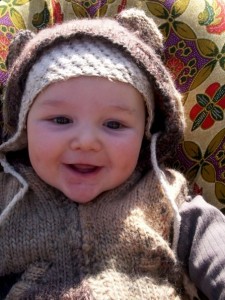 this age group specifically in the later books on childhood but again in Caplan’s The First Twelve Months of Life, we see that 44 to 48 weeks approximately is an age where the child has many more capacities to move more freely. Many can squat and stoop, and importantly stand alone and even wave and walk holding on. At the same time in the social area, Caplan describes that the child ‘increases dependence on the mother’ or major carer, inferring their intentions and even trying to ‘alter them through persuasion or protest.’ How fitting for a Mercury stage: this new mobility, the discovery of the capacity for persuasion and what we see in the social dependence on the major carer.
this age group specifically in the later books on childhood but again in Caplan’s The First Twelve Months of Life, we see that 44 to 48 weeks approximately is an age where the child has many more capacities to move more freely. Many can squat and stoop, and importantly stand alone and even wave and walk holding on. At the same time in the social area, Caplan describes that the child ‘increases dependence on the mother’ or major carer, inferring their intentions and even trying to ‘alter them through persuasion or protest.’ How fitting for a Mercury stage: this new mobility, the discovery of the capacity for persuasion and what we see in the social dependence on the major carer.
Also notable for an influence associated with Mercury is the increasing need for independence as is seen in the following descriptions: ‘Is not always cooperative. Refuses forceful teaching; opposes removal of toys; extends but does not release toy to person; likes imitating, then doing for himself; protests curtailment of play. Establishes meaning of “No.” Shows guilt at wrong doing. May tease and test parental limits.’ Caplan’s title for this month is “A Proper person”. It does have hints of Mercury rather than Moon, which comes before it!
The Mercury qualities continue in the last four weeks of this first year (48 to 52 weeks), as the remainder of this Stage 2, with tantrums and negativism increasing. Caplan describes this time ‘Stepping Out’:
By [48 weeks], many babies are ready to walk. This fascinating activity distracts the baby from what his mother and most adults consider basics—eating and sleeping. But there are even more profound consequences. The baby is able to get to people and things and to explore space and objects by himself in a way that will be far more efficient than crawling. He is also more independent of adult control. Yet fearful of this independence, he again grows anxious about strangers and separations from you. Beyond this, the balance between freedom and containment becomes an issue that you and your baby must mutually solve. Walking is the crowning achievement of this long and exciting “motor” year…
The exuberance and accomplishment radiating from your baby’s face show his recognition that he has attained another major goal…
Walking has a curious companion. Just as it appears, swimming behaviour begins to show in the tub…Now if you support your baby under the chest, his body will undulate, his arms will circle naturally at his sides, and his legs will kick alternately…
His determination when he first walks affords a precious glimpse of the inner force that pushes young animals from one level of development to the next and drives them to conquer their environments. His feelings also testify to the joy and pride that come from doing something by oneself…
‘Freedom’, ‘independence’, movement, walking and swimming, also the conflict between the need for independence and fear of separation are all consistent with Mercury qualities.
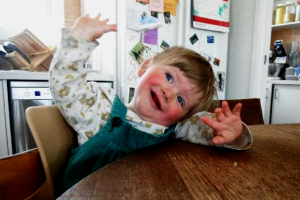
At this time too, we also see ‘From the two-handed reach of midyear, he now offers a preferred hand along the line of sight.’ A move from symmetry to asymmetry in hand preference, also consistent with Mercury qualities.
Caplan observes:
…The independence that walking inspires may further complicate meals and vex mothers. In fact, the baby may use food against you, much like his new “No’s” and even tantrums, as one aspect of his self differentiating and assertion over his environment….Many babies at this age interpret motherly participation as pressure and use it to key off a negative reaction to the whole meal. You might consider serving finger foods and leave choices to the child.
Is this Mercury’s need for freedom working itself out? Parents are being challenged to bring the child with them without threatening their freedom and independence, just as they will need to do at the next Mercury stage of Older Twos.
Caplan also describes how children of this age find it hard to quiet down to sleep and may need movement to settle. They naturally ‘rock on hands and knees’ and may bounce the crib across the room. He says ‘the best way to help the baby is an after dark session of crooning and gentle rocking as you feed him his last bottle. Although it may take as much as half an hour from your evening, feeling his tense little body begin to relax will be worth the time.’ This is again a Mercurial need for movement that we see in Older Two and Older Fives-Younger Six.
Overall these last two months of the first year in Gesell Stage 2 with Mercurial qualities are not easy. It can take new parents by surprise as ‘negativism increases’, and the child ‘refuses eating a meal, new foods, mother’s feeding; resists napping; may have tantrums.’ The child also ‘fears strange people and places. Reacts sharply to separation from mother.’ The resistances and troubles here are consistent with what we see in later Mercury stages and it is certainly not too soon to begin to learn how to accommodate the children’s needs while still getting the necessary things done.
In Summary
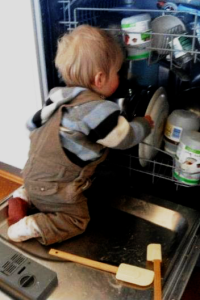 While it may be hard to identify the exact timing of the Gesell stages in the first year, it is interesting to observe that babies do experience different emphases in growth in an unfolding pattern consistent with the planetary qualities and order. With this pattern during the first year, each child is offered the opportunity to experience many different ways of relating to the world, some being more social and interactive, some more related to movement into the environment, some supporting independence, the growth of the self and uprightness; so we see that following birth (Saturn), the first months (Moon, Mercury and Venus) reflect the increasing social nature of children, and these are followed by an unfolding of bigger movement (Mars), strengthening (Jupiter)and uprightness which supports consciousness (Saturn again). Then the cycle begins again, still within this first year, with a stage of consolidation with practice of new skills, with new consciousness for self, others and emotions, (Moon), and finally a last stage which brings new demands for independence and movement, and new communication (Mercury).
While it may be hard to identify the exact timing of the Gesell stages in the first year, it is interesting to observe that babies do experience different emphases in growth in an unfolding pattern consistent with the planetary qualities and order. With this pattern during the first year, each child is offered the opportunity to experience many different ways of relating to the world, some being more social and interactive, some more related to movement into the environment, some supporting independence, the growth of the self and uprightness; so we see that following birth (Saturn), the first months (Moon, Mercury and Venus) reflect the increasing social nature of children, and these are followed by an unfolding of bigger movement (Mars), strengthening (Jupiter)and uprightness which supports consciousness (Saturn again). Then the cycle begins again, still within this first year, with a stage of consolidation with practice of new skills, with new consciousness for self, others and emotions, (Moon), and finally a last stage which brings new demands for independence and movement, and new communication (Mercury).
All these perhaps need more discerning observation but it may be that understanding the planetary qualities and influences better can teach us a lot in managing babies’ needs better.
View/download as pdf First Year
See also
Caplan, Frank (Gen ed) The First Twelve Months of Life Your baby’s growth month by month (Grosset & Dunlap New York, 1973)
Brief descriptions of planetary qualities for brief descriptions of mature planetary types.
One year old profile
Two year old profile
Womb to world
Strategies for healthy living with young children